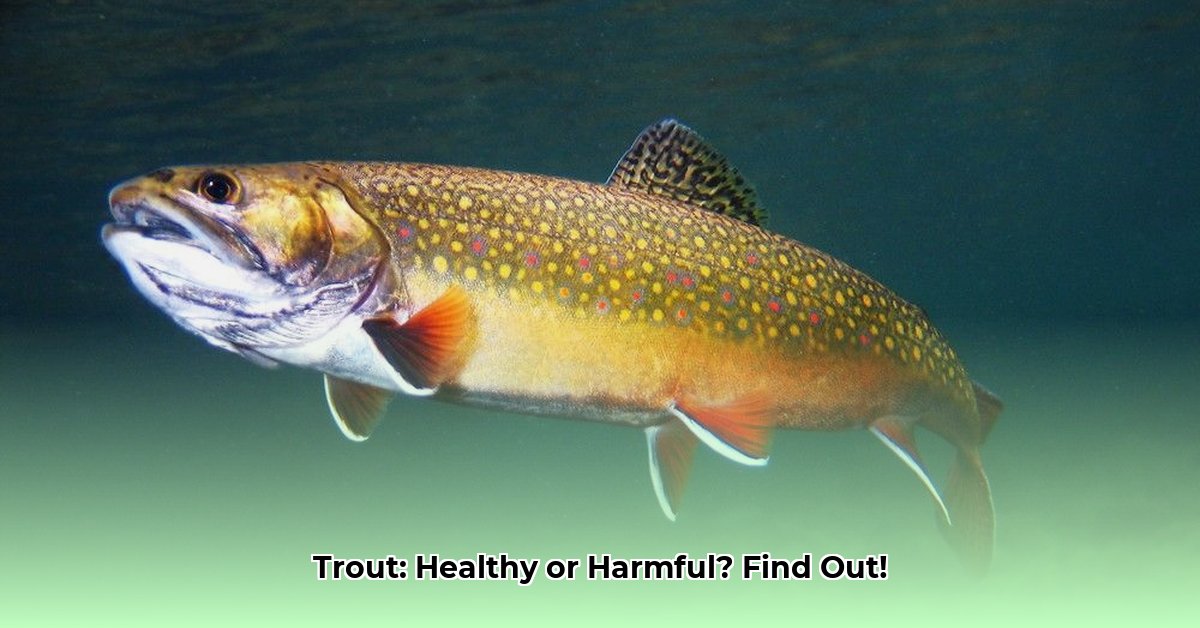So, is trout good for you? It’s a question many of us ask when we’re trying to eat healthier. This article will help you figure that out. We’ll look at what’s good and bad about eating trout, compare it to other fish, and discuss whether wild-caught or farmed trout is the better choice. We’ll keep it simple and clear, so you can easily understand everything and make the best choice for your diet. For comparison, you might also be interested in learning about the health benefits of other fish like grouper.
The Health Benefits of Eating Trout
Let’s talk trout! Is it a good fish to eat regularly, or should you avoid it? The answer, like most things related to health, isn’t a simple yes or no. It’s more of an “it depends.” Let’s dig into the details and figure out if trout deserves a spot on your dinner plate.
Trout: A Nutritional Powerhouse
Trout is a surprisingly nutritious fish. It’s packed with lean protein, which is great for building and repairing tissues and managing weight. The real stars are the omega-3 fatty acids. These healthy fats are amazing for your heart and help reduce inflammation throughout your body. Think of them as tiny, heart-healthy superheroes. You’ll also get a good dose of vitamin B12 (important for your nerves), vitamin D (essential for strong bones), and selenium, an antioxidant that helps protect your cells from damage.
Wild vs. Farmed Trout: A Nutritional Comparison
The story of trout nutrition gets a bit more nuanced when we consider its origin. Wild-caught trout and farmed trout present different nutritional profiles. Wild trout, swimming freely in their natural environment, often have slightly higher levels of certain nutrients due to their diverse diet. They tend to be leaner and have a richer flavor. However, farmed trout generally have lower levels of mercury, a heavy metal that can be harmful in high amounts. The farming methods can also affect the levels of other nutrients, such as omega-3 fatty acids, so it’s worth considering this. Deciding between wild and farmed depends on individual priorities – higher nutrient levels or lower mercury exposure.
Mercury Levels in Trout
Mercury is an important topic when discussing fish consumption. Some fish accumulate higher levels of this heavy metal as they age and consume other fish. The good news is that trout, especially farmed trout, generally contains lower levels of mercury than many other fish species. However, it’s still something to be aware of, especially if you’re eating wild-caught trout. The amount of mercury in wild trout can vary depending on where it was caught and its diet. Therefore, it’s best to consume trout in moderation, regardless of whether it’s wild or farmed. According to the EPA, children and pregnant women should be particularly mindful of their mercury intake.
| Fish Type | Mercury Level (Generally) | Omega-3s | Sustainability Concerns |
|---|---|---|---|
| Farmed Trout | Low | Moderate | Moderate |
| Wild-Caught Trout | Low to Moderate | High | Moderate to Low |
| Pacific Salmon (Wild) | Moderate | High | Low |
| Cod | Low | Low | Moderate |
| Sardines | Very Low | High | Low |
Note: Mercury levels and sustainability can vary widely based on specific sources and fishing practices.
Trout vs. Other Fish: Making Sustainable Choices
How does trout compare to other popular seafood options? Salmon, another omega-3 champion, offers similar benefits and might even have slightly more of those heart-healthy fats. Cod is a lean protein source, but it’s not as rich in omega-3s. Sardines are nutritional superstars, packed with omega-3s and calcium, and are generally a very sustainable choice. Larger fish like shark and swordfish tend to have much higher mercury levels, so it’s wise to limit their consumption. The Monterey Bay Aquarium’s Seafood Watch program offers detailed sustainability ratings for various fish species.
Integrating Trout Into a Healthy Diet
So, is trout healthy to eat? The answer is yes, but with caveats. A balanced diet is essential, including variety in seafood choices. Aim for a mix of different types of fish and consider smaller fish lower in the food chain. If you’re concerned about mercury, farmed trout could be a good option. If you prefer wild-caught, ensure you’re buying it from a reputable source. Remember, moderation is key! Nutritional guidelines generally suggest eating fish about two times a week, and diversifying your choices ensures a broad range of nutrients. Enjoy your delicious, and healthy, trout in moderation.
Choosing Sustainable and Low-Mercury Seafood
Key Takeaways:
- Trout offers excellent nutritional benefits, including high-quality protein and omega-3 fatty acids.
- Mercury levels and sustainability are crucial considerations when choosing between wild-caught and farmed trout.
- Understanding the nutritional profiles of different seafood options allows for informed dietary choices.
Trout’s Nutritional Benefits
Trout is a healthy choice, packing a nutritional punch. It’s a fantastic source of protein, vital for tissue building and repair. Trout is also rich in omega-3 fatty acids, essential fats linked to heart health and brain function. It provides a good dose of vitamins and minerals, including vitamin D and selenium. A 3-ounce serving of trout provides a significant portion of the recommended daily intake for these nutrients.
Wild-caught and farmed trout have nutritional differences. Wild trout generally have a higher omega-3 content and may be considered more sustainable. Farmed trout can be more readily available and cost-effective but may have a different fatty acid profile.
Assessing the Risks: Mercury and Contamination
While trout offers benefits, potential risks exist. Mercury, a neurotoxin, can accumulate in fish. Wild-caught trout may contain slightly higher mercury levels than farmed trout, though these levels are usually relatively low. Always check your sources! The Environmental Defense Fund provides guides to mercury levels in fish.
Bacterial contamination is another consideration. Proper handling and cooking are vital to prevent foodborne illnesses. Raw trout carries a higher risk than cooked trout.
Trout vs. Other Seafood: Making Informed Choices
How does trout compare to other seafood choices like Salmon, Cod, and Sardines? Salmon, like trout, is high in omega-3s. Cod offers a leaner protein source, lower in fat. Sardines are calcium and omega-3 nutritional powerhouses but can contain higher levels of contaminants.
| Seafood | Calories (per 3 oz) | Protein (grams) | Omega-3s (grams) | Mercury (ppm) | Sustainability Rating (MSC) |
|---|---|---|---|---|---|
| Trout | 143 | 20 | 0.7 | 0.071 | Certified/Improving |
| Salmon | 175 | 22 | 1.5 | 0.013 | Certified/Good Alternative |
| Cod | 70 | 15 | 0.2 | 0.111 | Certified/Avoid |
| Sardines | 177 | 23 | 1.4 | 0.013 | Certified |
This table offers a comparison based on averages. Actual values vary based on sourcing and preparation.
Sustainable Seafood Consumption
How to choose sustainable and low-mercury seafood:
- Prioritize sustainable sources: Look for certifications from organizations like the Marine Stewardship Council (MSC).
- Check mercury levels: Consult resources from government agencies like the FDA or EPA.
- Variety: Don’t rely solely on one type of fish to diversify nutrients and reduce the risk of single contaminant exposure.
- Proper cooking: Ensure seafood is thoroughly cooked to minimize bacterial contamination. Aim for an internal temperature of 145°F (63°C).
Following these steps improves the chances of enjoying seafood’s health benefits while mitigating risks. A balanced diet is key to a healthy lifestyle!
Optimal Seafood Choices for Dietary Health
Key Takeaways:
- Trout provides excellent nutritional benefits, including protein and omega-3 fatty acids.
- Wild-caught and farmed trout have differences in their nutritional content and potential risks.
- Mercury contamination should be a consideration, especially with larger, predatory fish.
Trout’s Nutritional Profile
Is trout a healthy addition to your diet? Absolutely! It’s packed with protein, essential for building and repairing tissues, and an excellent source of omega-3 fatty acids, known for heart-healthy properties. These fats act as tiny superheroes for your cardiovascular system and help lower the risk of heart disease. You’ll also find vitamins and minerals like vitamin D and selenium.
A 3-ounce serving of cooked trout offers approximately 19 grams of protein and 700-1000mg of omega-3 fatty acids. Getting enough vitamin D is a widespread concern, with many adults experiencing deficiencies.
Here’s
- Bento Box Glass Offers Practical, Eco-Friendly Meal Storage - December 16, 2025
- The Best Bento Box Price For Your Perfect Packed Lunch - December 15, 2025
- Bento Box Shopping Tips for Smart and Stylish Lunch Prep - December 14, 2025










